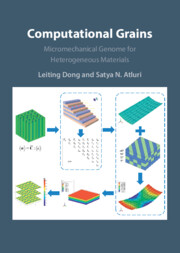Book contents
- Computational Grains
- Computational Grains
- Copyright page
- Contents
- Preface
- 1 Introduction
- 2 Computational Homogenization in the Micromechanics of Heterogeneous Materials
- 3 Direct Numerical Simulation of Materials Using Computational Grains
- 4 Trefftz Trial Functions for Computational Grains for Planar and 3D Problems
- 5 Computational Grains for Particulate Composites and Porous Materials
- 6 Computational Grains for Cylindrical Fiber Composites
- 7 Computational Grains for Nanocomposites
- 8 Computational Grains for Composites with Coated Inclusions
- 9 Computational Grains for Viscoelastic Composites
- 10 Computational Grains for Piezoelectric Composites/Porous Materials
- 11 Computational Grains with Embedded Microcracks in the Matrix and Inclusions
- 12 Multi-Scale Modeling of Composite Structures Using Computational Grains
- Index
- References
8 - Computational Grains for Composites with Coated Inclusions
Published online by Cambridge University Press: 05 October 2023
- Computational Grains
- Computational Grains
- Copyright page
- Contents
- Preface
- 1 Introduction
- 2 Computational Homogenization in the Micromechanics of Heterogeneous Materials
- 3 Direct Numerical Simulation of Materials Using Computational Grains
- 4 Trefftz Trial Functions for Computational Grains for Planar and 3D Problems
- 5 Computational Grains for Particulate Composites and Porous Materials
- 6 Computational Grains for Cylindrical Fiber Composites
- 7 Computational Grains for Nanocomposites
- 8 Computational Grains for Composites with Coated Inclusions
- 9 Computational Grains for Viscoelastic Composites
- 10 Computational Grains for Piezoelectric Composites/Porous Materials
- 11 Computational Grains with Embedded Microcracks in the Matrix and Inclusions
- 12 Multi-Scale Modeling of Composite Structures Using Computational Grains
- Index
- References
Summary
In this chapter, Computational Grains are developed for the direct micromechanical modeling of heterogeneous materials reinforced with coated particulate inclusions. Each CG is treated as a three-phase particle/coating/matrix grain, wherein the exact internal displacement field is assumed in terms of the P-N solutions that are further represented by the spherical harmonics. The Computational Grain program generates accurate homogenized moduli as well as exact local interphase stress distributions, with good agreement to the very fine-mesh FE technique and the CSA (Composite Sphere Assemblage) model. The effects of the material properties as well as the thickness of the coating system on the effective properties and localized stress concentrations are also examined for the CGs, where the former parameters play more important roles than the latter ones in altering the response of composite materials. Finally, a simpler implementation of periodic boundary conditions on the SERVEs is developed through the surface-to-surface constraints of the displacement field on the opposite faces. The developed CGs provide accurate and efficient computational tools in the direct modeling of the micromechanical behavior of the particulate composites reinforced with coatings/interphases, which cannot be easily accomplished by the off-the-shelf FE packages and classical models.
Keywords
- Type
- Chapter
- Information
- Computational GrainsMicromechanical Genome for Heterogeneous Materials, pp. 144 - 167Publisher: Cambridge University PressPrint publication year: 2023

